CRUCIFIXION was not the end . . .
What happened to Everyone after the crucifixion and where did everyone go?
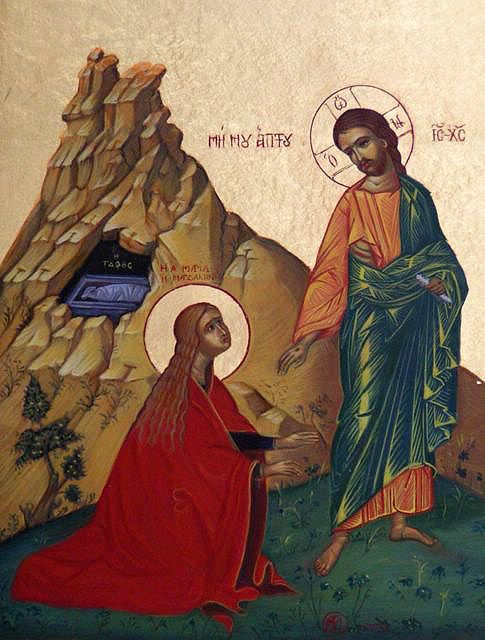 a Greek icon from Croatia of Mary, Jesus and the Tomb
a Greek icon from Croatia of Mary, Jesus and the Tomb
The Bible tells us that Jesus rose from the dead and forty days later, ascended into Heaven. This could have been inserted into the Gospel writings to prove two things; one, that his life had fulfilled the prophecies and that he was the true Messiah; and two, if he was not dead, and could go up and down to Heaven as he wished, the door was open for him to return to Judea if ever the political position changed enough to give him a second chance.
I think the latter is the case. Jesus was obliged to become a political refugee.
The Pharisees, the Romans and Herod himself all wanted to kill him. Obviously he had to disappear. Equally obviously, Mary had to disappear with him. Six weeks after the Crucifixion, they escaped from Judea. The word would be put around that he rose again from the dead and then ascended into Heaven.
Mary was three months pregnant with their baby. Lawrence Gardner, the author of The Magdalene Legacy, thinks they left Judea to protect the Holy Bloodline . . . I think they just wanted the best for their future baby.
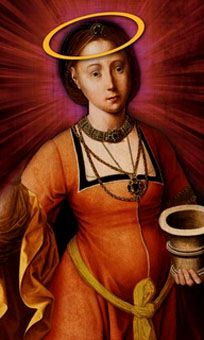 Heretical at the time; Mary was not permitted a halo until 1969
Heretical at the time; Mary was not permitted a halo until 1969
Many Christians find the idea shocking that Jesus and Mary Magdalene were living together. This is an offshoot of the old Judaic idea that women were the root of all evil, plus the modern Christian idea that Jesus was sinless, therefore sexless. But Mary and Jesus existed historically as human beings; they were not, at the time, Gods.
Jesus did not want to leave his disciples that he loved so much. At the end of St. Matthew, he says; And I will be with you always, to the end of the age. And in St John, 14, 18; When I go, you will not be left alone; I will come back to you. He didn’t want to go.
Then there was a great empty space in the lives of the disciples.
Who went where?
Then the disciples gathered in a room in Jerusalem to decide what to do. They went up to the room where they were staying, Peter, John, James and Andrew, Phillip and Thomas, Bartholomew and Matthew, James son of Alphaeus, Simon the Patriot, and Judas son of James, They gathered frequently to pray as a group, together with the women and with Mary the mother of Jesus and with his brothers. Acts, 1, 12 - 14. The verse mentions women disciples but does not name them.
Those researchers who believe that Jesus really ascended to Heaven expected Mary Magdalene to be there, and believe references to her were deliberately erased. I don’t agree with this. Mary wasn’t there because she wasn’t there. She had left with Jesus.
A few days later the disciples had another meeting with "120 other believers." Peter stood up and declared that, because Judas has left them, someone else must join them. The disciples drew lots to decide between two men who should join them and they chose Matthias. There's something mysterious and intriguing in this story of the meeting in Acts. There seems a great distinction between believers and disciples. The disciples had been twelve and now someone else must join them to keep the number at twelve. Why was twelve important? And when we hear of 120 believers being there, was someone writing in code? And why didn't they choose Lazarus as the twelfth, he who was so close to Jesus?
They didn't choose him because he wasn't there, he had gone to Marseille.
Most of those that Mary and Jesus left behind were from Capernaum, but Simon the Patriot could have been the Zealot, that the people chose over Jesus at the crucifixion. “Judas the son of James” was the son of Jesus’s brother James, James who was left in charge of the Jerusalem Church by Jesus. Judas, usually now called Jude, would have had descendants who later were called the Desposyni. Mary the mother of Jesus was there, in that Bible room, with his brothers, including presumably, Joseph of Arimathea.
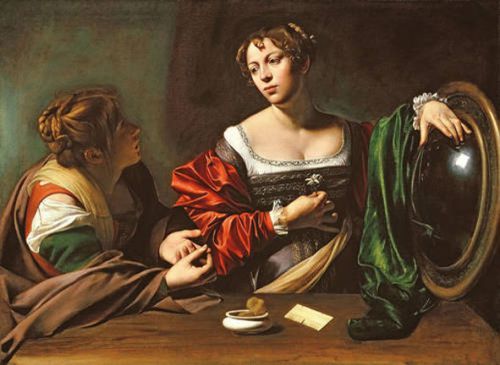 Martha and Mary Magdalene at home, by Carravaggio
Martha and Mary Magdalene at home, by Carravaggio
So, where were Martha and Lazarus, whose home at Bethany was only a mile away? At the time of the meeting, they were not listed because they had already left; for Marseille, I believe. What was there left for them in Judea, with Jesus and their sister Mary Magdalene gone to Gaul? They would not have stayed in Judea alone.
In the New Testament, in Acts or the later Letters, there is no mention whatsoever of Mary Magdalene, her sister Martha or her brother Lazarus.
During the crucifixion, Jesus had asked Lazarus to look after his mother, but Jesus hadn’t died. I believe Joseph of Arimathea then suggested that Lazarus should leave Judea, while Joseph would look after his mother, which was anyway generally accepted to be the duty of the eldest son. Lazarus had been in danger at Bethany (John 12, 9 - 11) The Pharisees were plotting to kill him, because many Jews were rejecting them and believing instead in Jesus, who had raised Lazarus from the dead.
There must have been collusion with Jesus about their destination, for Lazarus became the first bishop of Marseille but Martha, Mary Magdalene’s sister, went on from Marseille to Tarascon. Martha was not named again in the Bible after her sister anointed Jesus, but there are many legends about her, poor Martha who was always left to do the housework. But she couldn’t have been that feeble.
The book “Wild Thyme and Saladelle” tells us; After the Romans captured Jernica, they changed its name to Tarusco after the Tarasque, a ferocious dragon-monster with a lion’s head, spiked backbone and a long serpent tail, which the legend states devoured countless human victims and terrorized the district from its marshy lair, deep in the woods. . . . Saint Martha confronted the fearsome beast in its lair, pacified it with her crucifix and led it on a leash made from her girdle, three times around the walls of Tarascon. The beast was then either locked in a dungeon, or stoned to death, or else drowned in the Rhône. She slayed the dragon; symbolically, she banished evil. By this courageous action, Martha converted the entire town to Christianity and then worked many miracles.
In 1474, Good King René d’Anjou founded the Jeux de la Tarasque, to mark the occasion. Still today, a procession is held the second Sunday after Pentecost, with a home-made monster spouting smoke from its nostrils. On 29th July, Ste. Martha’s day, a week after Mary Magdalene’s day, a smaller procession is led round the town by a local maiden dressed as Martha.
In the church there still exists a 3rd century sarcophage, now part of the façade of the altar, reputed to be hers. The style is typically Roman. Since then Martha has worked many miracles.
I think we can assume she came to the Provence with Lazarus.
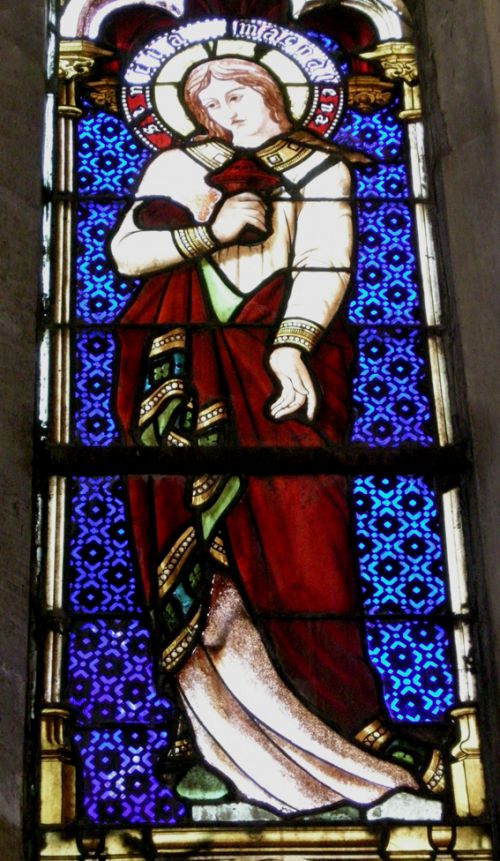 Ste Martha, in the church at Tarascon Picture by Jaap Rameijer
Ste Martha, in the church at Tarascon Picture by Jaap Rameijer
Alexandria
I am not the only person to think Mary and Jesus’s escape was masterminded by Joseph of Arimathea. But maybe I am the only one to think they were helped and guarded by Petronius - he was Roman and could provide a bodyguard, while Joseph of Arimathea had his own boats trading with Cornwall in south-west Britain.
A book was found in the library of the Emperor Theodosius (375 - 395) telling how Joseph was imprisoned by the Sanhedrin after the crucifixion. Pontius Pilate ordered the Sanhedrin to release him. Joseph and his tin business was far too valuable for the Romans to lose. This was described in the apocryphal “Acts of Pilate.” Gregory of Tours 544 - 595 also mentions this imprisonment in his history of the Franks.
Lawrence Gardner tells us that in 1601 a Cardinal in the Vatican wrote that Joseph came to Marseille in 35AD, then he crossed to Britain to preach the gospel. Gildas of Britain, who lived from 516 to 570, wrote that Christianity was carried to Britain in the last days of Tiberius. Tiberius died in AD37. Eusebuis of Caesarea (260 - 340) and St. Hilaire of Poitiers (330 - 367) also wrote of Joseph’s early visits to Britain.
In Britain, Joseph was greeted kindly by King Arviragus, brother of Caractacus the Pendragon. Joseph was granted twelve hides of Glastonbury land; a hide was equivalent to 120 acres, therefore the 12 hides were 1440 acres. He constructed a wattle-and-daub building for use as a church, maybe for his workers; it’s unlikely Joseph would have negotiated all this without business interests in mind. (The Domesday Book of 1086 said that Glastonbury had never paid tax.)
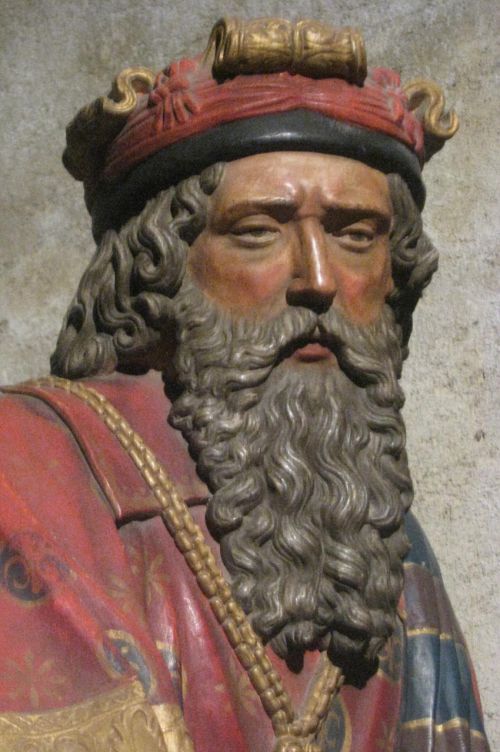
Joseph is traditionally represented as elderly with a grey beard; but I believe he was Jesus's brother.
The chronicler Gildas called Joseph of Arimathea a “noble decurio,” while Raban Maur, who wrote in the 8th century, called him a “noblis decurion.” A decurio was an overseer of mining estates and the term originated in Spain, where Jewish metalworkers had been operative in the celebrated foundries of Toledo since the 6th century BC. Tin was essential for the production of bronze and the most important tin mines in the Roman Empire were in south western England, an area rich also in copper and lead, for which there was a great market in the expanding Empire.
With the help of Joseph of Arimathea and Petronius, it’s likely Mary Magdalene and Jesus went through Alexandria, where there were regular passenger sailings to French ports like Marseille and Narbonne. Their knowledge of the Egyptian religion implies that they had studied there and at the time Alexandria was a home-from-home for the Jewish people.
However, we cannot assume Mary and Jesus were looking for particularly Jewish places to stay. With Joseph of Arimathea and Petronius on their side, they were becoming Romanised, and the Roman Empire had a vast network of quality paved roads on which middle-class people would travel. Everywhere of “the known world” at that time was part of the Roman Empire. Judea had been Roman since 63BC. This was the historical milieu in which Mary, Jesus and their friends lived and had their being - a Roman-occupied country.
But what about the others?
James stayed in Jerusalem until he was put to death by the Pharisees in 44AD. James’s son Jude was with him, or Jude could have been Jesus’s brother, for the Gnostic Gospels imply that the last of the Virgin Mary’s children were twin boys, called Jude and Thomas. Thomas is known as Doubting Thomas, after he had to be convinced that Jesus really was still alive. It’s believed Thomas went to India, and founded the Thomas church there.
Peter went to Jerusalem, to the church of James, Jesus’s brother, to preach as Jesus had asked him to. John (the son of Zebedee) was with them. Later Peter joined the converted Paul and went to Rome, where he was later executed. The Roman church tells us that he was the first bishop of Rome, being the leader of the Christians there, most of whom were in the catacombs under what is now St. Peter’s Church in Rome; but he spent most of those two years in prison. You can read it in Acts, and perhaps cry for poor Peter, who loved Jesus so much, and always believed Jesus would return.
The young disciple of Peter and Paul, Mark, known as John Mark in Acts, went to Alexandria and founded the Coptic church, around 50AD
What happened to Jesus’s mother Mary? Joseph of Arimathea took her to Anglesey, back to her Celtic roots. This is all written in the book, The Marian Conspiracy, by Graham Phillip. An amazing story, but I believe it to be basically true. The author’s logic convinced me that Angelsey, rather than Glastonbury, was the final home of the Virgin Mary.
The other women who were Jesus’s disciples
What had happened to the women who lived with Jesus in Capernaum, in Peter’s house, who “supported him of their substance” and became his disciples?
Salome is now known as Mary Salome, and was the wife of Zebedee - their children were the fishermen disciples, John and James. Salome was very close to the “inner circle.” I have an idea that she was particularly fond of the younger Mary Magdalene who had, we believe, lost her own mother. In the book, Pistis Sophia, Salome contributed to the question and answer session nearly as much as Mary Magdalene. Salome was there at the crucifixion, says St. Matthew. She was one of the women looking on from a distance, along with Jesus’s mother Mary. These three were there when Joseph of Arimathea prepared his brother’s body for the tomb, assisted by Nicodemus. Mary Salome, described as “the other Mary,” went with Mary Magdalene to the tomb the following Sunday morning, and Jesus told them both to go and tell the disciples what had happened.
In St Mark, the three women were again, Mary Magdalene, the Virgin Mary, and Mary Salome.
In St. John, the women at the Crucifixion comprised the Virgin Mary, Mary Magdalene, Mary the wife of Cleophas and the Virgin Mary’s sister. Standing close to Jesus’s cross were his mother, his mother’s sister, Mary the wife of Cleophas, and Mary Magdalene. So his mother’s sister, and Mary the wife of Cleophas, could have been the same person - the text doesn’t make it clear. Meanwhile, the term “sister” could have simply meant “fellow disciple” as we interpret the words brother and sister today.
However, Wikipedia, the online encyclopedia, states simply that Mary Jacobi was the wife of Cleophas. Cleophas was a disciple of Jesus but only mentioned once in the Bible, when he met up with Jesus at Emmaus.
Why is this of so much interest to us? The two Saints, Mary Jacobi and Mary Salome, left Judea after the Crucifixion and sailed to what is now Stes. Maries de la Mer. With them they had their servant, called Sara. In spite of all the stories about Mary Magdalene going there, and various saints going with her like Sidonie and Maximin, the town of Stes Maries de la Mer are convinced that the town belongs to the two Mary’s. There is no mention whatsoever in their literature of Mary Magdalene. The Mary’s were Mary Salome - an older woman? - and Mary Jacobi, the wife of Clophas.
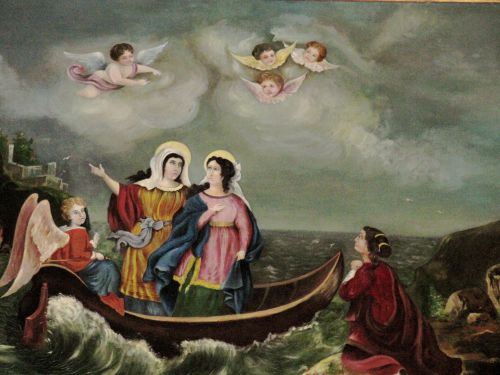
The two Mary's arriving at Stes. Maries de la Mer. Picture by Jaap Rameijer
The bodies of these two saints were found by René d’Anjou, when he excavated under the 6th century chapel on the oppidum of Râtis at Stes. Maries de la Mer in 1448. He immediately declared them to be Salomé and Mary Jacobi. How did he know? Nobody has ever explained this. The interesting thing was that René d’Anjou was devoted to Mary Magdalene - but he never claimed the bones were hers. I can think of only one reason. He knew they weren’t Mary Magadelene’s, because he knew where her bones really were. The following year he started the pilgrimages, now world-famous.
Sara has been adopted as the patron of the gypsies, but they only started coming to Stes Maries in the 15th century. And yet the old Celtic oppidum, on which today’s church was built, has existed since the 6th century BC and was known as the oppidum of Râ - it was named that by the Greeks. Sara, says a local legend, was a chieftain of the tribes living in the marshes when the two Marys arrived, and she helped them and gave them shelter, which is why the gypsies loved her.
What about Joanna, one of the women at the house of Peter? Joanna was the wife of Chuza, a “steward” or “Household manager” of Herod, in Herod’s Palace. Household stewards were often glorified slaves. Joanna may have “contributed to Jesus’s substance.” She was obviously close to Mary Magdalene, for she was among the women who went to prepare Jesus' body in Luke's account of the Resurrection.
Joanna must have come and gone to Peter’s house in absolute secrecy, she was after all the wife of the chief steward at Herod’s court, and at the end, she had the courage to support Mary Magdalene when the male disciples had disappeared into hiding, like thieves in the night. I like to think that she converted her husband, persuaded him to leave Herod’s Court, and they found a place in the country and retired.
The Roman soldier Petronius had to stay behind. There is no evidence that he was converted or baptised or remained anything than what he was; a friend who would help a friend who saved the life of his boy. I believe that is why he acted as an escort for Mary and Jesus, along the Roman roads to Alexandria; maybe he even saw them safely on board their ship.
Lastly, a woman called Susannah also supported Jesus in their Capernaum days. She is mentioned only this once in the Bible, and never heard of again. I think she was one of Jesus’s two un-named sisters.
Inscrivez-vous au site
Soyez prévenu par email des prochaines mises à jour
Rejoignez les 261 autres membres

